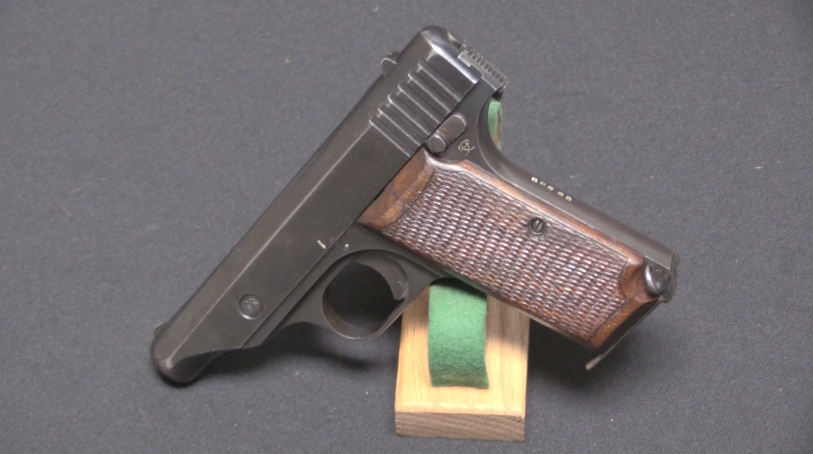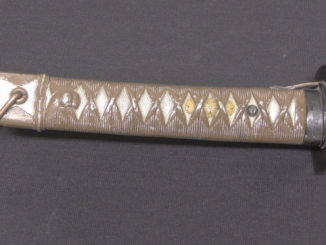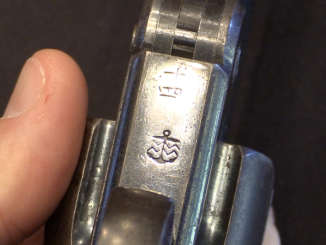If you are looking for gun info today, you really deserve to have something more elaborate than what I am able to write while on the road visiting family. So, I will direct you to the very detailed and photo-laden page Teri at Nambu World has put together on the Japanese Type 2 paratrooper Arisaka rifle. She’s done a very thorough job explaining the history and construction of the weapon, and and it’s well worth reading!
Nambu World: Arisaka Type 2 Paratroop Rifle





A really informative and well-written article. Many thanks to Teri and Ian with best wishes for a Merry Christmas and Prosperous New Year!
Nice present for this year, a somewhat fancy not-so-tactical-yet-very-tactical gun that can dodge the assault-weapons ban since its a manual bolt-action fed by clips. Surprisingly, nobody has actually used one for black-ops missions… or has someone done so?
Well, Andrew, I imagine that one armed with a Type 2 would get creamed by anyone with a modern autoloading rifle.
That depends. This would have been issued to a marksman, not a shock-trooper. Auto-loaders are better in chaotic open firefights, but a Type 2 would more concealable. If the particular Type 2 was accurate enough to have an offset scope fitted, the intended victim would never know what hit him. This is not a gun competing for rounds-per-minute. This is one that deals out full-strength kill-shots at medium-to-long range and can still have a bayonet fixed in case someone gets too personal while attacking the marksman.
And by the way, the guy with the Type 2 would likely have support from a partner armed with a Type 100 sub-machine-gun. While 8 mm Nambu is considerably weak compared to .45 ACP, it will likely make life unpleasant at the receiving end, especially if we’re talking about the victim getting 30 bullets at a rate of 450 rounds per minute in the gut at point blank.
Around 6 or 7 years ago I was working in this trucking depot when a manager there found out that I was a bit of a gun nut. He had some old Chinese or Japanese rifle or something that he wanted me to take a look at. Right, bring it in.
So a few days later he wanders up to my office with an Arisaka in tow. Pulls it out of the bag and I have a look. Great condition but it didn’t look… right. So I have a little play with it, turn a screw and clunk – the rifles comes apart.
Neat. He says you like it? Yeah, it’s great. Buy me a six pack and you can have it. Maybe. I have a hunt around online and find out, yeah, it’s a paratrooper rifle and not all that common at all. Next time I run into him I tell him it’s worth a bit more than a six pack. He contacted a gun dealer and got quite a substantial amount of money.
I’m still waiting for that karma to come back!
An excellent, comprehensive, and well-written article. Thanks for sharing this, Ian.
Was it this model that was used in the film “the Manchunian Candidate?”
Yep! In the 1962 film, a Type 2 was used as a sniper rifle, though the scope is obviously a commercial-brand add-on. To make matters more confusing, the rifle is described as a “Soviet two-piece.” Considering the Soviets’ hesitation to use untested tech, I doubt they would utilize anything like the Type 2 since it’s quite expensive compared to the good old Mosin-Nagant 91/30 rifle.
Well, first of all, most of Richard Condon’s writing shows that he doesn’t know much about firearms. (His description of a “takedown” M-1 Garand sniper rifle in Winter Kills is hilarious.) I doubt the filmmakers knew much more about rifles than he did.
Secondly, remember how much Japanese materiel’ the Russians and Red Chinese fell heir to in 1945. It wouldn’t have been any great trick for either side, but especially the PRC, to dig up a Type 2 from their stores, considering the treasure troves of small arms, etc., that were left in China and Manchuria. During the Revolution, about half of both the Communist and Nationalist forces were armed mainly with captured Japanese weapons up to and including field artillery.
cheers
eon
A sporterized one featured prominently in Dirty Harry with Clint Eastwood: http://www.imfdb.org/wiki/Dirty_Harry
Thanks Ian and Teri, and Merry Christmas, everybody at FW!
A “sporterized” Type 2 was also the rifle used by “Scorpio” (Andrew Robinson) in Dirty Harry (1971) starring (of course) Clint Eastwood. IIRC, that particular rifle was built by Stembridge Gun Rentals specifically for the film, and was chambered for .30-06 to allow the use of standard ’06 theatrical blanks. It was fitted with a Maxim (or possibly Parker-Hale?) suppressor (“silencer”), either real or a mockup, and a variable-magnification telescopic sight on what looked like prewar Mauser QD mounts. The scope is held at right angles to the barrel, the front mount drops down into a turret, then the scope is rotated a quarter-circle to slide the rear mount into a bayonet lock.
BTW, in the movie, Callahan says the rifle is a .30-06, but in the novelization, it’s described as a .30-30 Winchester. (?)
Stembridge also supplied Scorpio’s MP-40 and the “spy case” that held both the rifle and it accoutrements in the bottom, and the SMG and its spare magazines, etc., in the lid.
Of course, the movie never explains where an escaped mental patient, with no money, gets his hands on a setup that would have looked more reasonable in the hands of an intelligence agency “lion tamer” or a Mafia “Black Ace”.
Regarding the “stock” Type 2, I was impressed by the sight setup; very workmanlike and well-built even by peacetime standards. I noticed the neat “scallop” in the safety endcap; when the safety is “on”, there’s the curve of the drum in front of your eye to remind you to release it; the “scallop” lets you see the sights and tells you the rifle’s ready to fire. Very neat.
The “hard” release of the safety makes sense, too, as it would work very well to guard against ADs by troops wearing gloves in cold weather. People tend to forget, due to the island campaign, that the Imperial Army was expert in sub-arctic operations due to the climate of the home islands, as they proved in Manchuria and Siberia.
P.S., question;
Was the Type 2 ever equipped with the sliding bolt dust cover seen on the type 99?
cheers
eon
Yes, the early ones did come with dust covers from the factory.
Funny that we should mention the dust cover. I know that the popular view was that the noise would give the Arisaka away in a fight, but that really isn’t important and the noise issue is just the same as the Garand “ping.” In a brewing firefight, nobody can actually hear the rattling dust cover above the din of immediate gun fire. The dust cover was too fiddly during maintenance, that’s why it was tossed.
A well-written and very enlightening post, Eon — thank you. Per your last paragraph regarding the Imperial Army’s cold-weather operational experience, let’s not forget the Aleutians Campaign either.
There is one for sale here right now, oddly enough. Looks nice too.
http://forums.gunboards.com/showthread.php?342628-For-Sale-Japanese-Arisaka-Type-2-Paratrooper-Rifle
@ Doby Pilgrim :
I took a look at the photos posted by the seller on the Gunboards.com forum. Very nice, with a lot of detail and worth saving for reference purposes. According to the seller’s description, it was a wartime G.I. “bring-back” from the Pacific Campaign. He also indicated that while all the serial and assembly numbers for the parts within the rifle’s sub-assemblies matched, the numbers of the two main ( front and rear ) assemblies did not, indicating that one or the other had been swapped at one time, perhaps due to battle damage or even a G.I. putting together two of the best assemblies he could find from a captured batch of Arisaka’s. While this may not be so desirable in the eyes of many collectors, I personally think it may add to the historical value of this particular speciman, since in wartime parts and components were often replaced or swapped under duress with whatever was available.
BTW, the gun was sold at 0628 hrs. EST this morning, probably for the asking price of US$1500.
Thanks very much for the link.
The one that was for sale still had its dust cover and mum
…I just bought several guns over the past month, or I would definitely have bought that one.